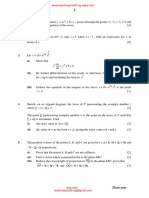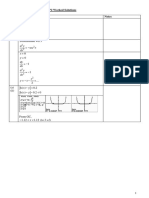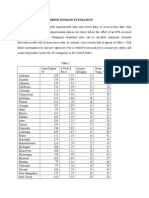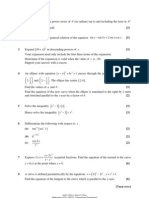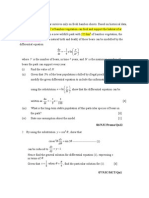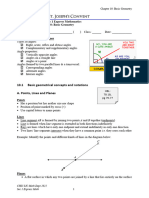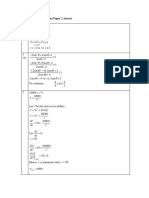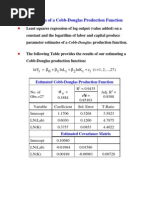2014 - DHS - Prelim Paper 2
2014 - DHS - Prelim Paper 2
Uploaded by
Ng Shu QingCopyright:
Available Formats
2014 - DHS - Prelim Paper 2
2014 - DHS - Prelim Paper 2
Uploaded by
Ng Shu QingOriginal Title
Copyright
Available Formats
Share this document
Did you find this document useful?
Is this content inappropriate?
Copyright:
Available Formats
2014 - DHS - Prelim Paper 2
2014 - DHS - Prelim Paper 2
Uploaded by
Ng Shu QingCopyright:
Available Formats
Dunman High School
2014 Prelim Paper 2
Section A: Pure Mathematics [40 marks]
1 (i) Prove by method of mathematical induction that
2
3 13 37 n 2 ( n + 1) + 1 n ( n + 1) 2
+ + + ... + = +1
(1)( 2 ) ( 2 ) ( 3) ( 3) ( 4 ) n ( n + 1) 2 ( n + 1)
for all positive integral values of n. [4]
r 2 ( r + 1) + 1 A B
(ii) Hence, by considering =r+ + , where A and B are constants
r ( r + 1) r r +1
n
to be determined, find an expression for r
r =1
in terms of n. [5]
x x
x
h
3x
An event company builds a tent (as shown in the diagram) which has a uniform
cross-sectional area consisting of an equilateral triangle of sides x metres and a
rectangle of width x metres and height h metres. The length of the tent is 3x metres.
(i) It is given that the tent has a fixed volume of k cubic metres and is fully covered
(except the base) with canvas assumed to be of negligible thickness. Show that
the area of the canvas used, A, in square metres, is given by
3 3 2 8k
A = 6x2 x + .
2 3x
Use differentiation to find, in terms of k, the value of x which gives a stationary
value of A. Determine if A is minimum or maximum for this value of x. [7]
(ii) It is given instead that the tent has a volume of 360 cubic metres and the area of
canvas used is 300 square metres. Find the value of x and the value of h. [3]
DHS 2014 Year 6 H2 Mathematics Preliminary Examination [Turn over
3 (i) Given w4 2 w2 + 2 = 0, find the roots of the equation, giving your answers in
the exact form rei , where r > 0 and < . [4]
(ii) Show the roots on an Argand diagram. [2]
(iii) The roots in (i) represented by w1 , w2 , w3 and w4 are such that
< arg( w1 ) < arg(w2 ) < arg(w3 ) < arg(w4 ) < . Explain why the locus of all
points z such that arg( z w1 ) = passes through the point that represents w3 .
8
Draw this locus on your Argand diagram and find its exact cartesian equation. [4]
x2 za
4 The line l has equation = , y = 1, where a is a real constant and
1 1
the plane p1 has equation 3 x + y + 2 z = 5. The point A has the position vector 2 i + 2 j
with respect to the origin O.
(i) Find the acute angle between l and p1. [2]
(ii) Find the perpendicular distance from the point A to p1. [3]
(iii) Given that l is the line of intersection of the planes p2 and p3 with
equations x 4 y + z = 6 and x y + bz = c , where b and c are real constants,
find b and c. [3]
(iv) The point B varies such that the midpoint of AB is always in p1. Find a cartesian
equation for the locus of B. [3]
Section B: Statistics [60 marks]
5 The organiser of an overseas education fair would like to survey 1% of the people
attending the one-day event on their opinions about the fair.
(a) The organiser has identified that the people at the event comprise students and
working adults and has decided to target these two groups for his survey.
Give one advantage of using a stratified sample in comparison to a sample
obtained by quota sampling. Suggest why it would be difficult for the organiser
to obtain a stratified sample. [2]
(b) Explain how the event organiser can conduct his survey using a systematic
sample. [2]
DHS 2014 Year 6 H2 Mathematics Preliminary Examination [Turn over
6 For a particular activity, three boxes A, B and C are placed in a circular arrangement.
A
Box A contains 5 red and 5 white balls.
Box B contains 4 red and 6 white balls. C B
Box C contains 3 red and 7 white balls.
For each round, a participant of this activity will draw a ball randomly from a box at
any one time without replacement. The participant begins his first draw from box A,
and the subsequent draws are based on the following rules:
If a red ball is drawn, the next draw is from the box in the clockwise direction.
If a white ball is drawn, the next draw is from the box in the anti-clockwise
direction.
(i) Show that the probability that a participant has not drawn from box C from the
1
first to the sixth draw is . [2]
36
(ii) Given that a participant drew from box B on the fourth draw, find the probability
that he has not drawn from box C from the first to his sixth draw. [4]
7 A group of eight girls and four boys take part in a Mathematics competition.
Among this group, there are six Chinese, four Malay, and
two Indian students.
For the individual segment, all students are arranged randomly in a row. Find the
probability that
(i) the boys are all separated from one another. [2]
(ii) a particular boy is between two girls. [2]
For the team segment, all students are arranged in a circle to facilitate discussion.
(iii) Find the probability that the boys are all next to one another. [1]
The group won the first prize and only seven students are chosen to represent the
group to receive the prize.
(iv) Find the probability that at least one student from each race are chosen to
represent the group. [3]
DHS 2014 Year 6 H2 Mathematics Preliminary Examination [Turn over
8 (i) Sketch a scatter diagram that might be expected for the case when x and y are
related approximately by y = a + b ln x , where a is positive and b is negative.
Your diagram should include 6 points, approximately equally spaced with
respect to x, and with all x- and y-values positive. [1]
About a year ago, Amy decided to go on a healthy eating lifestyle and an exercise
regime in order to lose weight. She monitored her weight, y kg, x months after she
started and the data is provided below.
No. of months, x 1 3 5 7 9 11
Weight, y 61.4 60.1 59.5 58.9 58.5 58.2
(ii) Draw the scatter diagram for these values, labelling the axes. [1]
(iii) Explain which model, y = a + b ln x or y = c + dx, is better for modelling these
values. [1]
For the better model that you have identified in part (iii),
(iv) give a contextual interpretation of the value of a or c and calculate the product
moment correlation coefficient. [2]
(v) use a suitable regression line to estimate the month in which she will reach a
weight of 55 kg. You may assume that the model is suitable for short term
predictions. [3]
(vi) explain, in context, why the model is not suitable for long term predictions. [1]
DHS 2014 Year 6 H2 Mathematics Preliminary Examination [Turn over
9 A baby drinks either BabyGrow or InfanGrow milk powder. The sleeping hours of
babies on a particular night follow independent normal distributions with means and
standard deviations as given in the table, according to the brand of milk powder they
drink.
Mean Standard deviation
BabyGrow 8.0
InfanGrow 6.5 0.795
(i) Given that 85% of babies who drink BabyGrow slept less than 9 hours, find the
value of . [2]
(ii) Twelve babies who drink BabyGrow are chosen at random. Find the probability
that at least ten babies slept more than 7 hours. [3]
(iii) Find the probability that the total sleeping hours of three randomly chosen
babies who drink BabyGrow exceeds four times the sleeping hours of a
randomly chosen baby who drinks InfanGrow, by more than one hour.
[3]
(iv) A study shows that 20% of babies who slept less than 5.5 hours developed
obesity when they grew up. A random sample of 300 babies who drink
InfanGrow is selected. Find the expected number of these babies who will
develop obesity when they grow up. [2]
DHS 2014 Year 6 H2 Mathematics Preliminary Examination [Turn over
10 To improve their learning, students book consultation appointments with their subject
tutors. For the Math subject, it is found that there is an average of 1.8 appointments in
a day.
Assume that the number of appointments follows a Poisson distribution.
(i) Find the probability that there are at most 6 Math appointments in a 5-day
period. What is the most likely number of appointments in the same period? [2]
(ii) The probability that there are exactly 3 Math appointments in a day is 0.161.
Out of a period of 30 days, find the least value of n such that the probability that
there are at most n days with exactly 3 Math appointments in a day is at least
0.95. [3]
State a reason, in context, why the Poisson distribution may not be a good model for
the number of appointments in a year. [2]
Students also book consultation appointments in the Science subject, where the
number of appointments in a day is an independent random variable with the
distribution Po ( 2.2 ) .
(iii) By using a suitable approximation, find the probability that in a 30-day period,
the number of Science appointments exceeds that of Math by more than 12. [4]
DHS 2014 Year 6 H2 Mathematics Preliminary Examination [Turn over
11 In Factory A, it is claimed that the mean mass of each bag of beans produced is 22 kg.
To investigate this claim, the mass, x kg, of a random sample of 50 bags of beans are
obtained and summarised by:
2
( x 18) = 165.3 and ( x 18) = 876.5.
(i) What do you understand by the term unbiased estimate? [1]
(ii) Find the unbiased estimates of the population mean and variance. [2]
(iii) Test at the 5% level of significance whether this claim is valid. [4]
(iv) State the meaning of the p-value obtained in part (iii). [1]
In Factory B, masses of bags of beans produced follow a normal distribution. It is
claimed that the mean mass of each bag of beans produced is 0 kg. A random sample
of 15 bags of beans has a mean mass of 8 kg and an unbiased estimate of the
population standard deviation is 0.2 kg. Given that there is sufficient evidence at the
5% level of significance to conclude that this claim has been overstated, find the set
of possible values of 0 . [4]
END OF PAPER
DHS 2014 Year 6 H2 Mathematics Preliminary Examination [Turn over
You might also like
- 2016 GCE H2 Math (9758) Specimen Paper I + AnswerDocument4 pages2016 GCE H2 Math (9758) Specimen Paper I + AnswerJulianNo ratings yet
- Chapter 13 Decision Analysis Test BankDocument42 pagesChapter 13 Decision Analysis Test BankFellOut X86% (7)
- Stat2507 FinalexamDocument12 pagesStat2507 Finalexamyana22100% (1)
- AJC H2 Math 2013 Prelim P2Document6 pagesAJC H2 Math 2013 Prelim P2nej200695No ratings yet
- MJC 2015 H2 J1 Math Promos QuestionsDocument7 pagesMJC 2015 H2 J1 Math Promos QuestionsAlxNo ratings yet
- Ri h2 Math p2 SolutionsDocument11 pagesRi h2 Math p2 SolutionsjimmytanlimlongNo ratings yet
- 4047 SP 01Document6 pages4047 SP 01MaverickNo ratings yet
- Nyjc H2 Math P2Document6 pagesNyjc H2 Math P2jimmytanlimlongNo ratings yet
- 2010 TJC SolDocument12 pages2010 TJC SolPooja KapurNo ratings yet
- VJC JC1 H2 Maths 2015 Promo QuestionDocument5 pagesVJC JC1 H2 Maths 2015 Promo QuestionGM MonsterEtaNo ratings yet
- 2007 IJC PrelimDocument23 pages2007 IJC PrelimWen LongNo ratings yet
- NYJC 2009 Prelim H2 P2 QuestionDocument14 pagesNYJC 2009 Prelim H2 P2 QuestioncjcsucksNo ratings yet
- 2017 H2 Prelim (Integration Techniques)Document6 pages2017 H2 Prelim (Integration Techniques)toh tim lamNo ratings yet
- 2020 NYJC H2 Math Prelim Paper 1 QuestionsDocument5 pages2020 NYJC H2 Math Prelim Paper 1 QuestionsFanny ChanNo ratings yet
- JJC h2 Maths p2 SolutionDocument12 pagesJJC h2 Maths p2 SolutionNg Shu QingNo ratings yet
- 2014 MI Prelim P2Document7 pages2014 MI Prelim P2Ng Shu QingNo ratings yet
- Yield Management at American Airlines: Flight 445Document4 pagesYield Management at American Airlines: Flight 445mannan010% (1)
- Simulating A Basketball Match With A Homogeneous Markov Model and Forecasting The OutcomeDocument11 pagesSimulating A Basketball Match With A Homogeneous Markov Model and Forecasting The OutcomeMichalis Kasioulis100% (1)
- Anis Case Study of Soft Drink Demand EstimationDocument10 pagesAnis Case Study of Soft Drink Demand EstimationNorhanisah Han75% (4)
- MJC JC 2 H2 Maths 2011 Mid Year Exam Questions Paper 1Document8 pagesMJC JC 2 H2 Maths 2011 Mid Year Exam Questions Paper 1jimmytanlimlongNo ratings yet
- VJC JC 2 H2 Maths 2011 Mid Year Exam QuestionsDocument4 pagesVJC JC 2 H2 Maths 2011 Mid Year Exam QuestionsjimmytanlimlongNo ratings yet
- ACJC Maths Promos 2005Document3 pagesACJC Maths Promos 2005Suphadetch LeungNo ratings yet
- 1exp Topical Assignment 3aDocument2 pages1exp Topical Assignment 3aNidhi Sharma PuranikNo ratings yet
- SRJC JC 2 H2 Maths 2011 Mid Year Exam Questions Solutions Paper 1Document18 pagesSRJC JC 2 H2 Maths 2011 Mid Year Exam Questions Solutions Paper 1jimmytanlimlongNo ratings yet
- RI JC 2 H2 Maths 2011 Mid Year Exam QuestionsDocument6 pagesRI JC 2 H2 Maths 2011 Mid Year Exam QuestionsjimmytanlimlongNo ratings yet
- H2 Math Topical Worksheet (Applications of Integration)Document4 pagesH2 Math Topical Worksheet (Applications of Integration)Tim Gan MathNo ratings yet
- 2018 H2 Prelim Compilation (Binomial Distribution)Document16 pages2018 H2 Prelim Compilation (Binomial Distribution)toh tim lamNo ratings yet
- 2010 AJC Paper 2Document5 pages2010 AJC Paper 2Fang Wen LimNo ratings yet
- Hci H2 Math P2Document6 pagesHci H2 Math P2jimmytanlimlongNo ratings yet
- MJC JC 2 H2 Maths 2011 Mid Year Exam Questions Paper 2Document10 pagesMJC JC 2 H2 Maths 2011 Mid Year Exam Questions Paper 2jimmytanlimlongNo ratings yet
- Worksheets - 12TH - 2020-21Document2 pagesWorksheets - 12TH - 2020-21Lalan KumarNo ratings yet
- Ch. 4. Determinants WorksheetDocument3 pagesCh. 4. Determinants WorksheetBiju Thomas HPS RNo ratings yet
- Ah Sem 2Document10 pagesAh Sem 2JASON_INGHAMNo ratings yet
- Https:Tohjid - Sgp1.digitaloceanspaces - com:Sgfreepapers:Exam-papers:2018:Junior-college:Jc1:2018 Jc1 Math PromoDocument333 pagesHttps:Tohjid - Sgp1.digitaloceanspaces - com:Sgfreepapers:Exam-papers:2018:Junior-college:Jc1:2018 Jc1 Math PromoliusihanNo ratings yet
- Chapter 5 INTRODUCTION TO TRIGONOMETRYDocument5 pagesChapter 5 INTRODUCTION TO TRIGONOMETRYLiyakath AliNo ratings yet
- Quadratic Sequences Questions MMEDocument6 pagesQuadratic Sequences Questions MMEVimalNo ratings yet
- Multiplying and Dividing FractionsDocument12 pagesMultiplying and Dividing FractionsCarl Jerome CallantaNo ratings yet
- Answer All Question in This SectionDocument12 pagesAnswer All Question in This SectionSaifulAhmadNo ratings yet
- Quiz Review Normal DistributionDocument2 pagesQuiz Review Normal DistributionAzka Hamdah (Yr. 22-24)No ratings yet
- DistributionDocument15 pagesDistributionaaryamann guptaNo ratings yet
- Converting Repeating Decimals To FractionsDocument2 pagesConverting Repeating Decimals To FractionsLiezl AclanNo ratings yet
- 2006 JC 1 H2 JCT & Promo - Differential EquationsDocument3 pages2006 JC 1 H2 JCT & Promo - Differential EquationsOccamsRazorNo ratings yet
- RI H2 Maths 2013 Prelim P2 SolutionsDocument10 pagesRI H2 Maths 2013 Prelim P2 Solutionsnej200695No ratings yet
- 2010 AJC H2 Math Promo With AnswersDocument8 pages2010 AJC H2 Math Promo With AnswersCindy KrisnadiNo ratings yet
- 2006 AJC H2 Maths Promo - QuestionsDocument6 pages2006 AJC H2 Maths Promo - QuestionsniveumaNo ratings yet
- 1 (A) Suppose The Following Facts Are Known About The Function G and Its DerivativeDocument5 pages1 (A) Suppose The Following Facts Are Known About The Function G and Its DerivativeShereen LimNo ratings yet
- 24 Transformation of Curves DONEDocument31 pages24 Transformation of Curves DONEABDULLAH SHAHZADNo ratings yet
- H2 Math Topical Worksheet (Complex Numbers)Document2 pagesH2 Math Topical Worksheet (Complex Numbers)Tim Gan MathNo ratings yet
- S3 Final Exam (09-10) (Marking)Document13 pagesS3 Final Exam (09-10) (Marking)Anson Ka Kin ChanNo ratings yet
- 2020 EOY Math PapersDocument11 pages2020 EOY Math PapersNonNo ratings yet
- P1 Past Years 2013 - 2021Document21 pagesP1 Past Years 2013 - 2021NURUL ATIKAH ZainalNo ratings yet
- PS HL Trigonometry PDFDocument2 pagesPS HL Trigonometry PDFABC123No ratings yet
- 10 - Linear LawDocument4 pages10 - Linear LawJASON_INGHAMNo ratings yet
- Math NotesDocument12 pagesMath NotesKirthika JaganNo ratings yet
- Nanyang Girls' High School End-Of-Year Examination 2018 Secondary Four Integrated Mathematics 1Document10 pagesNanyang Girls' High School End-Of-Year Examination 2018 Secondary Four Integrated Mathematics 1NonNo ratings yet
- Solved Examples Type I. Problems Based On Direct Use of Rules of Integration and Formulae For Standard IntegralsDocument2 pagesSolved Examples Type I. Problems Based On Direct Use of Rules of Integration and Formulae For Standard IntegralsRupesh JhaNo ratings yet
- Dunman High School 2009 Maths D Paper 1 Answer KeyDocument28 pagesDunman High School 2009 Maths D Paper 1 Answer KeyZeneonNo ratings yet
- SJI VS ChemDocument290 pagesSJI VS ChemfarhanaNo ratings yet
- Mathematics HL Paper 1 PDFDocument16 pagesMathematics HL Paper 1 PDFGloria TaylorNo ratings yet
- IGCSE Differenatiation MathDocument22 pagesIGCSE Differenatiation MathRozer oPNo ratings yet
- Unit 3 RevisionDocument15 pagesUnit 3 RevisionP RushitaNo ratings yet
- Exponents and Logarithms 2Document20 pagesExponents and Logarithms 2samkelisiwemandisa56No ratings yet
- 1 (A) Solve The Inequality (B) Hence, State The (I) (Ii)Document13 pages1 (A) Solve The Inequality (B) Hence, State The (I) (Ii)Joann NgNo ratings yet
- Acjc h2 Math p2 SolutionsDocument8 pagesAcjc h2 Math p2 SolutionsjimmytanlimlongNo ratings yet
- A Watermelon Is Assumed To Be Spherical in Shape While It Is Growing. Its MassDocument4 pagesA Watermelon Is Assumed To Be Spherical in Shape While It Is Growing. Its MassHANSNo ratings yet
- 2010 Yjc H2ma Prelim p1Document4 pages2010 Yjc H2ma Prelim p1cjcsucksNo ratings yet
- 2014 TPJC Prelim p11Document5 pages2014 TPJC Prelim p11Ngo Duy VuNo ratings yet
- 2016 MJC Prelim H2-Mathematics Paper-1Document8 pages2016 MJC Prelim H2-Mathematics Paper-1Ng Shu QingNo ratings yet
- MF26Document12 pagesMF26Ng Shu QingNo ratings yet
- 4 < − 1 2 ≤ ≤ θ θ θ θ θ θ (2sin) 4 (2 sin) 2 1 (2 sin) 4 − + + ≥ + 2sin 4 < − 2si 2 1 n ≤ ≤ θDocument6 pages4 < − 1 2 ≤ ≤ θ θ θ θ θ θ (2sin) 4 (2 sin) 2 1 (2 sin) 4 − + + ≥ + 2sin 4 < − 2si 2 1 n ≤ ≤ θNg Shu QingNo ratings yet
- VJC Model Essay Final SDocument106 pagesVJC Model Essay Final SNg Shu QingNo ratings yet
- 4 < − 1 2 ≤ ≤ θ θ θ θ θ θ (2sin) 4 (2 sin) 2 1 (2 sin) 4 − + + ≥ + 2sin 4 < − 2si 2 1 n ≤ ≤ θDocument6 pages4 < − 1 2 ≤ ≤ θ θ θ θ θ θ (2sin) 4 (2 sin) 2 1 (2 sin) 4 − + + ≥ + 2sin 4 < − 2si 2 1 n ≤ ≤ θNg Shu QingNo ratings yet
- KS Bull 2015 Issue 2Document14 pagesKS Bull 2015 Issue 2Ng Shu QingNo ratings yet
- 2016 TPJC Prelim h2 Math Paper 1 SolutionDocument11 pages2016 TPJC Prelim h2 Math Paper 1 SolutionNg Shu QingNo ratings yet
- CJC p1 SolutionDocument22 pagesCJC p1 SolutionNg Shu QingNo ratings yet
- GP Essay - Do Foreigners Bring More Problems Than Benefits To Your Country PDFDocument2 pagesGP Essay - Do Foreigners Bring More Problems Than Benefits To Your Country PDFNg Shu QingNo ratings yet
- 2017 Singapore-Cambridge Gce A-Level Examination Examination Timetable (Updated As at 15 February 2017)Document10 pages2017 Singapore-Cambridge Gce A-Level Examination Examination Timetable (Updated As at 15 February 2017)Ng Shu QingNo ratings yet
- GP Essay - Do Foreigners Bring More Problems Than Benefits To Your Country PDFDocument2 pagesGP Essay - Do Foreigners Bring More Problems Than Benefits To Your Country PDFNg Shu QingNo ratings yet
- Chemistry: Higher 2 (2017) (Syllabus 9647)Document45 pagesChemistry: Higher 2 (2017) (Syllabus 9647)Ng Shu QingNo ratings yet
- SulotionDocument20 pagesSulotionMuhammad Nadeem KhanNo ratings yet
- Psychrometry LectureDocument3 pagesPsychrometry LectureDana Mae YarteNo ratings yet
- Chapter 9 Chat LongDocument31 pagesChapter 9 Chat Longbanana567No ratings yet
- Tolerances and FitsDocument12 pagesTolerances and FitskoitkulperNo ratings yet
- Cobb Douglas and Returns To ScaleDocument6 pagesCobb Douglas and Returns To ScalemolnarandrasNo ratings yet
- Wind Speed in Sri Lanka PDFDocument15 pagesWind Speed in Sri Lanka PDFsandrock92100% (1)
- EQT 373 - Test1Document8 pagesEQT 373 - Test1Mae SyNo ratings yet
- Business Mathematics and Statistics E-Sample PDFDocument36 pagesBusiness Mathematics and Statistics E-Sample PDFCaroline NdiranguNo ratings yet
- Cs3353 Fds Unit 3 Notes EduenggDocument47 pagesCs3353 Fds Unit 3 Notes EduenggGanesh KumarNo ratings yet
- IBP Special Topic Webinar Statistical Forecasting: Tod Stenger and Anna Linden February 17, 2016Document30 pagesIBP Special Topic Webinar Statistical Forecasting: Tod Stenger and Anna Linden February 17, 2016chongNo ratings yet
- Data AssimilationDocument29 pagesData Assimilationjikku joyNo ratings yet
- CT UncertaintyDocument11 pagesCT Uncertaintymadan1981100% (1)
- Anova Slides PresentationDocument29 pagesAnova Slides PresentationCarlos Samaniego100% (1)
- The Toulmin Model of ArgumentationDocument7 pagesThe Toulmin Model of ArgumentationantsereneNo ratings yet
- Forest Tree InformationDocument53 pagesForest Tree InformationPrabhakar GadhaveNo ratings yet
- Enhanced Math 1 Stats ReviewDocument2 pagesEnhanced Math 1 Stats Reviewethan nguyenNo ratings yet
- Scientific MethodDocument5 pagesScientific MethodPretheepa GengatharenNo ratings yet
- EViews TutorialDocument86 pagesEViews TutorialNatia TsikvadzeNo ratings yet
- Statistics Idiots Guide!: Dr. Hamda QotbaDocument20 pagesStatistics Idiots Guide!: Dr. Hamda QotbakksunNo ratings yet
- SAP PA Automated TimeSeriesTutorialDocument31 pagesSAP PA Automated TimeSeriesTutorialMuneeb AliNo ratings yet
- StatisticiansDocument4 pagesStatisticiansKhamis TugbangNo ratings yet
- SQQS1013 Elementary Statistics: Possibility A Particular Event Will OccurDocument33 pagesSQQS1013 Elementary Statistics: Possibility A Particular Event Will OccurAmeer Al-asyraf MuhamadNo ratings yet
- Lecture 9.0 - StatisticsDocument39 pagesLecture 9.0 - StatisticsMohanad SulimanNo ratings yet
- Hydrological Modeling in GisDocument77 pagesHydrological Modeling in Gisepidamus1980No ratings yet
- Concrete WorksDocument39 pagesConcrete WorksNorazmiMohdNorNo ratings yet










